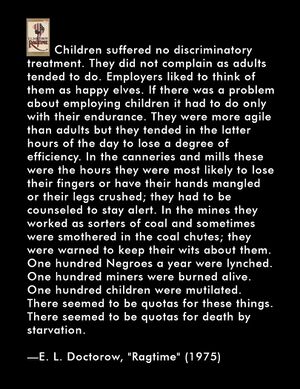Ragtime (nonfiction)
Jump to navigation
Jump to search


"Children suffered no discriminatory treatment. They did not complain as adults tended to do. Employers liked to think of them as happy elves. If there was a problem about employing children it had to do only with their endurance. They were more agile than adults but they tended in the latter hours of the day to lose a degree of efficiency. In the canneries and mills these were the hours they were most likely to lose their fingers or have their hands mangled or their legs crushed; they had to be counseled to stay alert. In the mines they worked as sorters of coal and sometimes were smothered in the coal chutes; they were warned to keep their wits about them. One hundred Negroes a year were lynched. One hundred miners were burned alive. One hundred children were mutilated. There seemed to be quotas for these things. There seemed to be quotas for death by starvation."
—E. L. Doctorow, Ragtime (1975)
—E. L. Doctorow, Ragtime (1975)
Ragtime is a novel by E. L. Doctorow, published in 1975. It is a work of historical fiction mainly set in the New York City area from 1902 until 1912.
In 1998, the Modern Library ranked Ragtime number 86 on its list of the 100 best English-language novels of the 20th century. TIME included the novel in its TIME 100 Best English-Language Novels from 1923 to 2005.
In the News
Fiction cross-reference
Nonfiction cross-reference
External links
- Ragtime (novel) @ Wikipedia